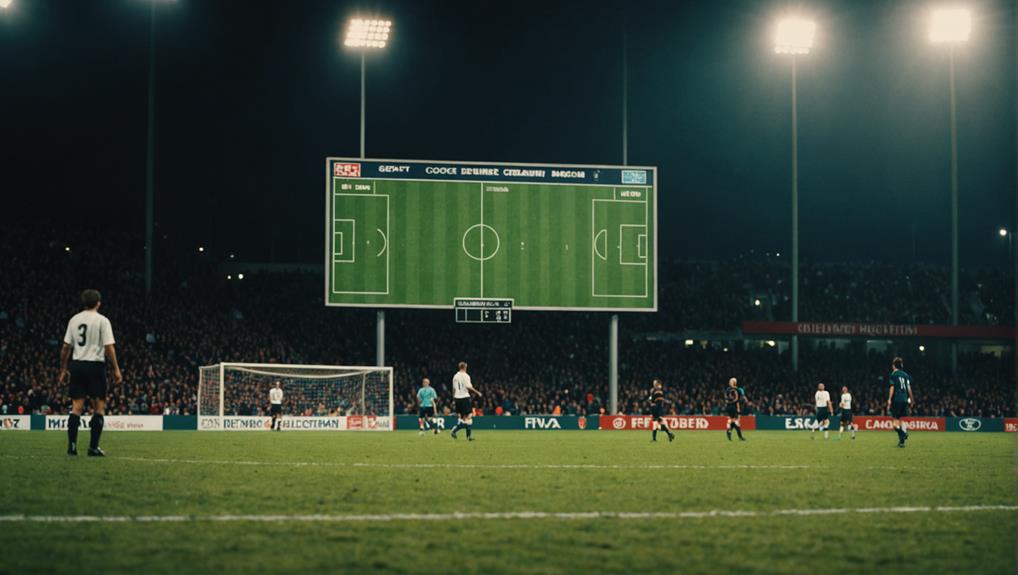
How Many Periods Are There in Soccer?
July 10, 2024In soccer, there are two periods in a match, each lasting 45 minutes. Between them, you get a 15-minute halftime break. But remember, referees can add extra time for stoppages. This structure applies whether you're playing professionally, in college, or at youth level. Just know that total playing time might vary due to stoppage time. If you're curious about how halftime impacts the game and what happens during those breaks, there's more to discover about the strategic elements of halves and the role of coaches in optimizing performance.
Two Periods in a Match
In soccer, a match consists of two periods, each typically lasting 45 minutes. These two periods are separated by a 15-minute halftime break, allowing players to rest, strategize, and make necessary gameplay adjustments. Professional soccer games, college matches, and youth competitions all adhere to this structure, ensuring consistency across different levels of play.
The format of two periods in a soccer match provides teams with equal opportunities to showcase their skills and compete for victory. It also gives referees the authority to add stoppage time at the end of each period to account for any delays that may have occurred during gameplay.
This additional time helps maintain fairness and accuracy in game timing, ensuring that the match is played in accordance with the rules and regulations.
Length of Each Period
The duration of each period in a soccer match varies depending on the level of play and the age group involved. In professional soccer, there are typically two periods, each lasting 45 minutes, with a 15-minute halftime break. This structure is consistent across most professional leagues worldwide.
On the other hand, youth soccer games may have varying formats, such as two halves, four quarters, or other configurations based on age groups.
High school soccer matches generally consist of two 40-minute periods or four 20-minute periods, providing a balance between the length of professional games and the developmental needs of younger players.
It's essential to recognize that additional time can be added at the end of a period by the referee for factors like substitutions, injuries, or time-wasting. Additionally, the end of a period can be extended to accommodate a penalty kick if necessary in a tied game.
Understanding the length of each period is vital for players, coaches, and fans to grasp the dynamics of the game.
Half-Time Break Duration

During the half-time break in soccer, you have a chance to catch your breath, rehydrate, and focus on the game plan.
It's a pivotal moment for players and coaches to make strategic adjustments based on the first half's performance.
Half-Time Break Importance
Players benefit greatly from the 15-minute half-time break in soccer, allowing for physical recovery and tactical adjustments. During this essential interval, players have the opportunity to rest, rehydrate, receive medical treatment if needed, and regroup for the second half of the game.
The half-time break serves as a moment for players to recover from the physical demands of the first half, helping to prevent fatigue and injuries as the match progresses. Additionally, coaches utilize this time to make strategic changes to game plans, analyze the opponent's tactics, and communicate necessary adjustments to their team.
This break isn't merely a pause in the game but a strategic pause that can significantly impact the outcome of the match. By taking advantage of the half-time break to rest, rehydrate, regroup, and make tactical changes, players can enter the second half refreshed and ready to execute their game plan effectively.
Half-Time Strategy Adjustment
Half-time in soccer presents an opportunity for teams to reassess their strategies and make critical adjustments before heading back onto the field. During this standardized 15-minute break, coaches analyze the team's performance in the first half, pinpoint weaknesses, and devise new strategies to improve their gameplay. It's a pivotal moment where players can rest, hydrate, receive medical attention if necessary, and mentally prepare for the remainder of the game. The break serves as a chance to motivate the team, address any issues that arose during the initial half, and set the tone for a strong second-half performance.
The standardized length of the half-time break ensures fairness in game intervals and allows teams to make informed adjustments efficiently. Effective half-time strategy adjustments can be decisive in turning the tide of a match, with teams often using this break to refocus, regroup, and implement new tactics to secure a competitive edge on the field.
Total Playing Time
The total playing time in a standard soccer match consists of two 45-minute periods. During these periods, stoppage time may be added by the referee for delays like injuries or substitutions.
If the game ends in a tie, extra time of two 15-minute halves can be played, with penalty kicks as a tiebreaker if needed.
In youth soccer games, the periods may be shorter, typically two 20-minute halves depending on the age group.
It's worth noting that the total playing time in soccer can vary due to factors like injuries, substitutions, and time-wasting tactics employed by teams to maintain a lead or disrupt the flow of the game.
Extra Time in Knockout Matches

In knockout matches, extra time serves as an extension to the regular gameplay, offering teams a chance to break a tie before resorting to a penalty shootout.
The concept of added time in these pivotal moments can bring about intense suspense and excitement as teams battle to secure a victory within the extended period.
Understanding the stoppage time rules during extra time is essential for both players and fans to grasp how match outcomes may be influenced.
Knockout Match Extensions
After regulation time in knockout matches, teams engage in an additional 30 minutes of play known as extra time to break a tie and determine a winner. This extra time is divided into two 15-minute halves, extending the game duration and providing teams with more opportunities to score.
In the past, the golden goal rule was in effect during extra time, where the first team to score would win the match. However, this rule has been eliminated, and if the score remains tied after extra time, the match proceeds to a penalty shootout to determine the winner.
Extra time in knockout matches, especially in prestigious tournaments like the FIFA World Cup, plays a pivotal role in deciding advancing teams to the next round. It adds an element of suspense and excitement as teams battle it out for victory within the additional 30-minute extension.
Added Time Concept
Knockout matches in soccer introduce the concept of added time, also known as stoppage time or injury time, to accommodate delays and guarantee fairness in determining a winner. Referees play an important role in deciding the amount of added time, ensuring that the game's integrity is maintained despite interruptions.
Here are some key points regarding added time in soccer:
- Added time is necessary to make up for time lost due to various stoppages during a match, such as injuries, substitutions, or deliberate time-wasting tactics.
- The determination of added time is at the discretion of the match officials, who consider the nature and extent of delays before announcing the additional minutes.
- In knockout stages, if a match remains unresolved after regular time, extra time is played, followed by a potential penalty shootout to determine the advancing team.
Understanding the significance of added time is essential for comprehending the dynamics of soccer matches, especially in critical knockout fixtures.
Stoppage Time Rules
During crucial knockout matches in soccer, referees implement stoppage time rules to safeguard for delays and uphold the integrity of the game. Stoppage time is added at the end of each half to compensate for time lost due to injuries, substitutions, and other events that occurred during regular playing time.
The referee has the authority to determine how much stoppage time is needed based on the circumstances and events that unfolded. This additional time guarantees that the total duration of the game is equitable and precise, allowing for a complete match. The range of stoppage time can vary, from a few minutes to several minutes, depending on the referee's judgment.
In knockout matches or playoffs, extra time may be introduced after regulation time ends, giving teams another opportunity to break a tie before resorting to penalty kicks. These rules aim to provide a level playing field and uphold the competitive nature of the sport.
Strategic Elements of Halves
Strategically utilizing the halftime break in soccer matches allows teams to analyze performance, adjust tactics, and plan for the second half effectively.
Making tactical adjustments based on the first half's performance.
Substituting players to manage fatigue and bring fresh energy.
Refining game plans to capitalize on strengths and exploit opponents' weaknesses.
Teams leverage the break between halves to recalibrate strategies, address any shortcomings, and ensure players are physically and mentally prepared for the remainder of the match.
It's a pivotal moment where coaches provide vital feedback, players rehydrate and recharge, and the team as a whole regroups.
Understanding the strategic elements of halves is essential for optimizing performance, maintaining the right pacing throughout the game, and ultimately securing a competitive edge.
Conclusion
So there you have it – in soccer, there are two periods in a match. The intensity of the game builds up over each half, with teams strategizing and adapting to their opponents.
The halftime break provides a brief respite before the action kicks off again. It's a thrilling game of two halves, where every moment counts and every goal could be the difference between victory and defeat.
Enjoy the excitement of each period as you watch the beautiful game unfold.


